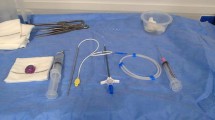Abstract
Purpose: To assess safety and function of central venous port systems implanted percutaneously in the interventional radiology suite.
Methods: One hundred and twenty-five consecutive ports in 123 patients were evaluated retrospectively. One hundred and twenty ports were implanted via the subclavian vein.
Results: Technical success was 100%. Fourteen patients (11.2%) experienced immediate procedural complications, all minor (pneumothorax 1.6%). During follow-up (4–343 days, mean service period 97.8 days), nine complications occurred, six of which were major. These were three port infections which led to hospitalization and port removal, one chamber penetration through the skin, and two port occlusions. Port removal as a result of complications was performed in six patients. Altogether, 20 complications occurred within a total of 11,056 days of service, which means 1.8 events per 1000 days of service.
Conclusion: Percutaneous implantation of central venous port systems is safe and easy to perform. Complication rates of this study compare favorably with those of other radiological and surgical series.
Similar content being viewed by others
Author information
Authors and Affiliations
Rights and permissions
About this article
Cite this article
Lorch, H., Zwaan, M., Kagel, C. et al. Central Venous Access Ports Placed by Interventional Radiologists: Experience with 125 Consecutive Patients. Cardiovasc Intervent Radiol 24, 180–184 (2001). https://doi.org/10.1007/s002700001721
Published:
Issue Date:
DOI: https://doi.org/10.1007/s002700001721




